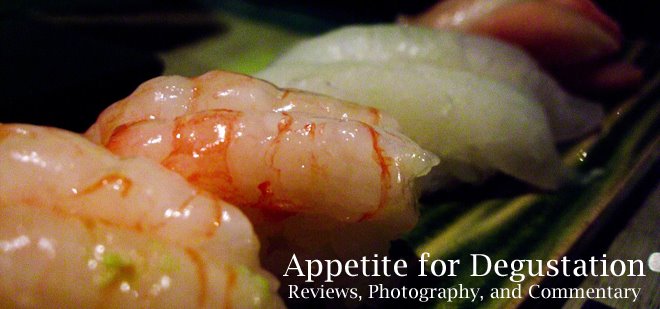 New Jersey teaches a New Yorker learns something new about sushi.
New Jersey teaches a New Yorker learns something new about sushi.At the Mitsuwa Marketplace in Edgewater, NJ, I came across a tray of sushi labeled "Saba Battera." I knew that "saba" was the Japanese word for mackerel, but I did not recognize the second word. Since I've accepted the inevitability of encountering unfamiliar words when eating Japanese, what really intrigued me about this sushi was not so much the name, but rather, the fact that the rice was yellow and was speckled with scallions. The reasonable assumption was that "battera" refered to the jaundiced rice. It didn't.
Battera sushi is a type of hako sushi ("box sushi") which in turn is a type of sushi from Osaka named oshi sushi ("pressed sushi"). The word "battera" is derived from the Portuguese (the first Europeans to reach Japan) word bateria, which means small boat. According to the Sushi Encyclopedia, an Osaka restaurant, in 1893, began using "battera" to refer to its gizzard shad sushi because it resembled a boat. The term evolved, and today, battera sushi refers exclusively to boxed sushi topped with mackerel. Considering this, it was redundant for the label to refer to its contents as "saba battera".
As seen in the photograph, the sushi is much more brick-shaped than the hand-molded nigiri sushi with which most Americans are more familiar. With hako sushi, the rice is lightly pressed into a box-shaped mold and any toppings are laid and pressed upon the rice. This solid block is then cut into rectangular pieces.
Sushi Monster describes the making of battera sushi slightly differently. According to that site, a layer of asipidistra leaves are first placed at the bottom of the box. The next layer is the mackerel, and the last is the rice. This arrangement helps preserve the mackerel because it has minimal contact with air and is in direct contact with the vinegared rice. Sushi Monster also says that the mackerel is salted, then rinsed with a vinegar mixture. As I researched for this article, I learned that mackerel is almost universally first cured before serving. Eating raw mackerel is unsanitary, and is only done by fisherman and those in close proximity to where the fish is caught.
What of the yellow rice and scallions? I wasn't able to find information via Google about it, which suggests that it probably is not a common or recognized variant of sushi.
So, how did my $6.99 saba battera taste? As good as its vehicular equivalent, the Volvo, is curvy. The special rice added nothing to the flavor, and the fish was tough and dry in texture and bland in taste. This, of course, is not the result of the fact that it was battera sushi. The battera/hako process only has to do with shaping the sushi and has nothing to do with anything that would affect the flavor.
I'll be going to Japan for about a week in September. I'll be sure to try battera sushi with uncured mackerel and other non-nigiri sushis. As soon as I do, I'll share my experiences with everybody.
Arigato gozaimasu for reading.
Thanks to:
http://www.sushimonsters.com/tutorials-start-types-oshi.php
http://www.sushiencyclopedia.com/sushi/types_of_sushi.html
http://www.sushiencyclopedia.com/blog/2007/10/04/portuguese-sushi-battera/
http://www.sushiencyclopedia.com/sushi_menu/mackerel_sushi.html
http://www.thenibble.com/reviews/main/fish/seafood/sushi-glossary.asp

2 comments:
Aşçı Forum
Aşçı İş Arayanlar
Aşçı Arayanlar
Yerli Yemek Tarifleri
Aşçı Okulları
Dünya Global Mutfak
Profesyonel Yemek Malzemeleri
Profesyonel Sos çeşitleri
If the saba in your battera was dry and bland, they didn't make it right. The yellow scallioned rice should be proof that they don't know what they're doing. Battera is one of the most flavorful and pungent sushi available if prepared correctly. It should be very tart and fishy-tasting but not in a bad way. And when prepared correctly it is moist and springy.
Post a Comment